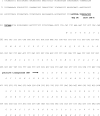Identification and sequence of a tet(M) tetracycline resistance determinant homologue in clinical isolates of Escherichia coli
- PMID: 17015654
- PMCID: PMC1636245
- DOI: 10.1128/JB.00705-06
Identification and sequence of a tet(M) tetracycline resistance determinant homologue in clinical isolates of Escherichia coli
Abstract
The presence of the tetracycline resistance determinant tet(M) in human clinical isolates of Escherichia coli is described for the first time in this report. The homologue was >99% identical to the tet(M) genes reported to occur in Lactobacillus plantarum, Neisseria meningitidis, and Streptococcus agalactiae, and 3% of the residues in its deduced amino acid sequence diverge from tet(M) of Staphylococcus aureus. Sequence analysis of the regions immediately flanking the gene revealed that sequences upstream of tet(M) in E. coli have homology to Tn916; however, a complete IS26 insertion element was present immediately upstream of the promoter element. Downstream from the termination codon is an insertion sequence that was homologous to the ISVs1 element reported to occur in a plasmid from Vibrio salmonicida that has been associated with another tetracycline resistance determinant, tet(E). Results of mating experiments demonstrated that the E. coli tet(M) gene was on a mobile element so that resistance to tetracycline and minocycline could be transferred to a susceptible strain by conjugation. Expression of the cloned tet(M) gene, under the control of its own promoter, provided tetracycline and minocycline resistance to the E. coli host.
Figures











Similar articles
-
Occurrence of tetracycline resistance genes among Escherichia coli isolates from the phase 3 clinical trials for tigecycline.Antimicrob Agents Chemother. 2007 Sep;51(9):3205-11. doi: 10.1128/AAC.00625-07. Epub 2007 Jul 9. Antimicrob Agents Chemother. 2007. PMID: 17620376 Free PMC article.
-
Diversity of the tetracycline resistance gene tet(M) and identification of Tn916- and Tn5801-like (Tn6014) transposons in Staphylococcus aureus from humans and animals.J Antimicrob Chemother. 2009 Sep;64(3):490-500. doi: 10.1093/jac/dkp214. Epub 2009 Jun 16. J Antimicrob Chemother. 2009. PMID: 19531603
-
New Tn916-related elements causing erm(B)-mediated erythromycin resistance in tetracycline-susceptible pneumococci.J Antimicrob Chemother. 2007 Jul;60(1):127-31. doi: 10.1093/jac/dkm120. Epub 2007 May 5. J Antimicrob Chemother. 2007. PMID: 17483548
-
Molecular identification of tetracycline resistance genes in Escherichia coli isolates from internal organs of swine sold on Abakaliki, Nigeria.Open Vet J. 2025 Jan;15(1):171-178. doi: 10.5455/OVJ.2025.v15.i1.16. Epub 2025 Jan 31. Open Vet J. 2025. PMID: 40092188 Free PMC article. Review.
-
Antibiotic resistance plasmids and mobile genetic elements of Clostridium perfringens.Plasmid. 2018 Sep;99:32-39. doi: 10.1016/j.plasmid.2018.07.002. Epub 2018 Jul 26. Plasmid. 2018. PMID: 30055188 Review.
Cited by
-
Molecular characterization of the tet (M)-carrying transposon Tn7124 and plasmids in Escherichia coli isolates recovered from swine.Front Vet Sci. 2024 Oct 23;11:1430398. doi: 10.3389/fvets.2024.1430398. eCollection 2024. Front Vet Sci. 2024. PMID: 39507219 Free PMC article.
-
Antimicrobial resistance and molecular characterization of Klebsiella species causing bovine mastitis in Nghe An province, Vietnam.J Adv Vet Anim Res. 2023 Mar 31;10(1):132-143. doi: 10.5455/javar.2023.j662. eCollection 2023 Mar. J Adv Vet Anim Res. 2023. PMID: 37155534 Free PMC article.
-
Emergence of a Novel tet(L) Variant in Campylobacter spp. of Chicken Origin in China.Antimicrob Agents Chemother. 2020 Dec 16;65(1):e01622-20. doi: 10.1128/AAC.01622-20. Print 2020 Dec 16. Antimicrob Agents Chemother. 2020. PMID: 33046498 Free PMC article.
-
IS26-Flanked Composite Transposon Tn6539 Carrying the tet(M) Gene in IncHI2-Type Conjugative Plasmids From Escherichia coli Isolated From Ducks in China.Front Microbiol. 2019 Jan 15;9:3168. doi: 10.3389/fmicb.2018.03168. eCollection 2018. Front Microbiol. 2019. PMID: 30697195 Free PMC article.
-
Occurrence of tetracycline resistance genes among Escherichia coli isolates from the phase 3 clinical trials for tigecycline.Antimicrob Agents Chemother. 2007 Sep;51(9):3205-11. doi: 10.1128/AAC.00625-07. Epub 2007 Jul 9. Antimicrob Agents Chemother. 2007. PMID: 17620376 Free PMC article.
References
-
- Akiba, T., K. Koyama, Y. Ishiki, S. Kimura, and T. Fukushima. 1960. On the mechanism of the development of multiple-drug-resistant clones of Shigella. Jpn. J. Microbiol. 4:219-227. - PubMed
-
- Allard, J. D., M. L. Gibson, L. H. Vu, T. T. Nguyen, and K. P. Bertrand. 1993. Nucleotide sequence of class D tetracycline resistance genes from Salmonella ordonez. Mol. Gen. Genet. 237:301-305. - PubMed
MeSH terms
Substances
Associated data
- Actions
LinkOut - more resources
Full Text Sources

